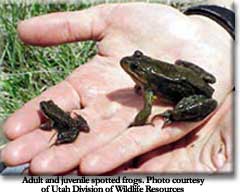 Columbia spotted frog, Rana luteiventris,
ranges from southeast Alaska through Alberta, Canada, and into
Washington, Idaho, Wyoming, Montana, and disjunct areas of Nevada and
Utah. In Utah, isolated Columbia spotted frog populations exist in the
West Desert and along the Wasatch Front. Habitat loss and degradation
have caused declines in many of these populations, especially along the
Wasatch Front, leading to the species' inclusion on the Utah Sensitive Species List.
The Mitigation Commission is working cooperatively with several
government agencies under a Conservation Agreement to eliminate or
significantly reduce threats facing the Columbia spotted frog, with a
goal of recovering the species. Columbia spotted frog, Rana luteiventris,
ranges from southeast Alaska through Alberta, Canada, and into
Washington, Idaho, Wyoming, Montana, and disjunct areas of Nevada and
Utah. In Utah, isolated Columbia spotted frog populations exist in the
West Desert and along the Wasatch Front. Habitat loss and degradation
have caused declines in many of these populations, especially along the
Wasatch Front, leading to the species' inclusion on the Utah Sensitive Species List.
The Mitigation Commission is working cooperatively with several
government agencies under a Conservation Agreement to eliminate or
significantly reduce threats facing the Columbia spotted frog, with a
goal of recovering the species.
To aid spotted frog recovery, the Mitigation
Commission is acquiring properties in a natural spring area west of Mona
in Juab County, Utah. The area supports spotted frog, least chub and
California floater (mollusk). Only two locations in Juab County are
known to support spotted frog populations. Acquiring and protecting this
habitat is a vital component toward assuring conservation of this
species along the Wasatch Front, and therefore aids measures identified
in the Conservation Agreement to which the Commission is signatory.
Spotted frog recovery will also be aided by a
proposed warm-water hatchery in Utah. Production numbers are identified
for the proposed Warm-water
and native aquatic species culture facility to include spotted frog
and boreal toad, as well as, June sucker, least chub, leatherside chub,
roundtail chub and flannelmouth sucker.
The Provo River
Restoration Project, which is restoring the middle Provo River
between Jordanelle Dam and Deer Creek Reservoir to a more natural
pattern and ecological function, is also expected to contribute to
spotted frog recovery. The project area contains the largest remaining
population of Columbia spotted frog within the Wasatch Front. Spotted
frogs are significantly benfitting from the project because it is
creating and improving wetlands and protecting, enhancing and restoring
riverine and riparian habitats.
In 1999, eighteen wetlands were created in the
first year of the Provo River Restoration Project. By the following
spring, sixty percent of the new wetlands contained breeding frogs.
Individual frogs were observed in an even greater proportion of these
wetlands. Many adult frogs appeared out of nowhere to colonize the new
wetlands and appeared to be actively using them throughout the river
restoration’s 2000 construction season. Many more wetlands are being
created through subsequent construction seasons with similar success.
A comprehensive spotted frog monitoring plan is
being implemented in conjunction with the restoration project. The
monitoring plan’s purpose is to provide a protocol for documenting
immediate and long-term responses of frogs to restoration. Monitoring
involves a full inventory of spotted frog use in the Provo River
corridor done annually throughout the restoration project and five years
of habitat recovery. All wetlands in the corridor are mapped and
standardized surveys are conducted for spotted frog use in each wetland
site.
On September 20, 2001 the U.S. Fish and Wildlife
Service published a notice of intent to conduct a status review for the
Wasatch Front population of spotted frog. On August 30, 2002 the U.S.
Fish and Wildlife Service announced (Federal Register Vol. 67, No. 169)
after a 12-month review of all the available scientific and commercial
information, that listing the Wasatch Front population of the Columbia
spotted frog is not warranted.
|